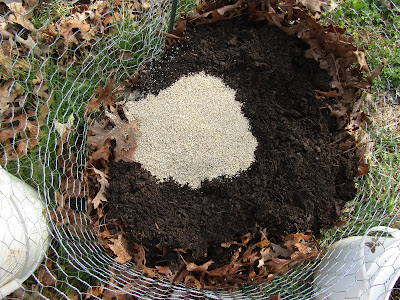Welcome back to Garden Friday.
Each week, we share what's going on in our North Carolina gardens.
There is so much gardening going on right now,
that it may require daily posts to get caught up!
It's ALL GO(O)D!
Last week, we showed you how we created potato towers.
I've gotten feedback on this method,
some folks swear by it, others say they didn't have much success with it.
With the towers in place, it was time to plant the taters.
They were cured for a few days,
which just means that they are left to dry out.
We sliced them in half and placed them on a cookie sheet which was covered with a large rag
and placed them on top of the refrigerator.
The vital step in this process is to make sure that you have at least 3 "eyes" on each piece.
These are the spots where the potato leaves sprout and grow up.
Our materials were gathered and we headed outside.
I decided to make things interesting by planting with three different types of fertilzer.
In all three towers, vermiculite was added to the soil.
This soil is from a big box store and wasn't as loose as I'd like,
so the vermiculite should help with aeration and drainage.
In the first tower, rabbit poop was added.
I had gotten this supply from a fellow vendor at the
Mooresville Farmers' Market last season.
The second tower was fed with compost tea,
made from turkey poop and aged a good, long while.
In the third tower, the turkey poop (Mighty Grow) that I found at Ford's Seeds
(where I also bought the seed potatoes)
(where I also bought the seed potatoes)
was added. It will be interesting to see if there are any differences in growth.
Each tower got 7 seed potatoes, nestled into the soil and amendments.
The cut side is placed down against the soil
so that the "eyes" can find the sun.
The spuds were then covered with a layer of soil.
The spuds were then covered with a layer of soil.
The pinkish bumps can be seen here
and if all goes according to plan,
that's where the leaves start to sprout.
After some heavy rain, I noticed some of the potatoes were peeking out of the soil.
That's a no-no. Potatoes don't like the sun.
If they are exposed to sun and start to turn green,
they are not fit to eat, and can make a body very ill.
If they are exposed to sun and start to turn green,
they are not fit to eat, and can make a body very ill.
Only the leaves should be showing themselves,
so I added a layer of composted straw to cover them up.
They've been watered each day when we've had no rain.
They will continue to be water only as needed,
and hopefully, soon, we will be seeing some foliage popping up!
Once the leaves start to head for the sky,
more soil is added, and then more mulch or straw.
This is done a few times until harvest.
One astounding discovery was made earlier in the week
as I was adding leaves to the leaf mulch bin.
This pile was already quite large when we bought the house.
We have an abundance of leaves on the property.
I decided to dig into it to see what might be taking up residence there.
Once the leaves start to head for the sky,
more soil is added, and then more mulch or straw.
This is done a few times until harvest.
One astounding discovery was made earlier in the week
as I was adding leaves to the leaf mulch bin.
This pile was already quite large when we bought the house.
We have an abundance of leaves on the property.
I decided to dig into it to see what might be taking up residence there.
Jackpot!
All sorts of wonderful slimy critters were hanging out.
What a goldmine for the garden!
I'll be adding some of these workhorses to the containers
and any beds I may decide to throw together.
They do a fabulous job of composting and adding nutrients to the soil.
There are plans in the works to start a worm bin,
but I guess I have a good running start!
Although we are still having temperatures overnight in the 30's,
Mother Nature is screaming for spring to begin!
Look at these lovely, delicate Grape Hyacinths (thanks for the i.d., Ben)
we have speckling our property.
we have speckling our property.
After these have finished blooming,
the plan is to relocate them into some of the established beds,
although these bulbs are fairly easy-going
and can even be transplanted while blooming.
although these bulbs are fairly easy-going
and can even be transplanted while blooming.
From all accounts, this looks like the foliage of a tulip.
I was thinking maybe they are some sort of parrot tulip,
but now I'm not so sure.
There is so much to learn about all of these amazing bulbs shooting up.
What a treat to witness all of God's handcrafted wonder.
What's going on in your garden this spring?


















No comments:
Post a Comment
Thanks for taking the time to leave your thoughts!